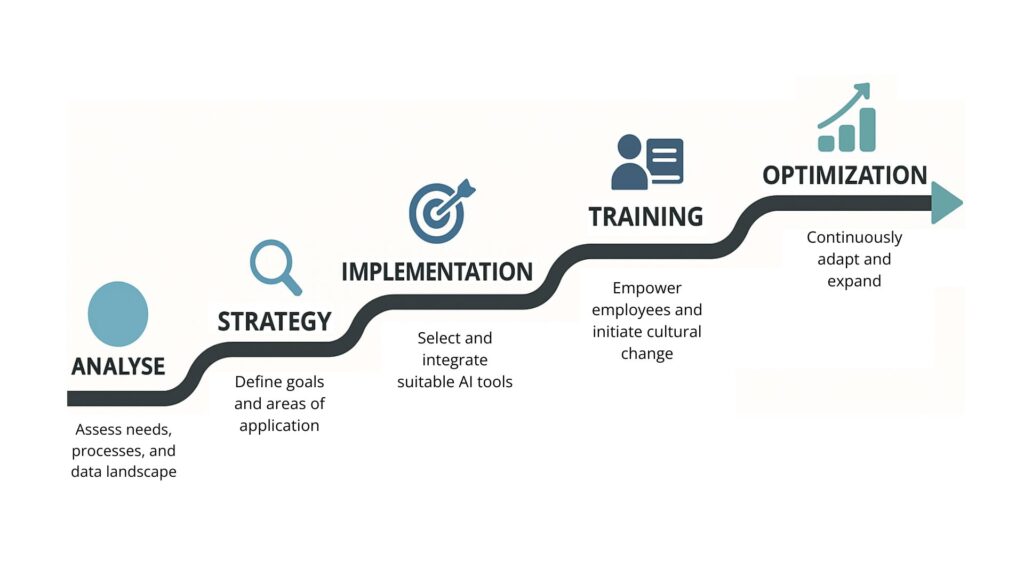
The most important facts in brief
The integration of artificial intelligence (AI) in companies is becoming a decisive factor for competitiveness and innovation. When implemented correctly, AI not only increases efficiency in processes and production workflows, but also opens up completely new business models. A clear AI strategy, high-quality data and the ability to win over employees for the change are crucial to success. Companies that follow this path consistently can not only reduce costs in the new era of digitalization, but also strengthen their role in the business world in the long term.
Vereinbaren Sie mit uns einen kostenfreien Beratungstermin.
Beratungstermin vereinbarenHow AI integration is now transforming companies
AI integration in companies is not only changing individual processes, but the entire way organizations work. Driven by modern AI technologies, previously separate IT systems are being connected, creating new synergies. In production, for example, intelligent algorithms take over predictive maintenance tasks, while in sales, AI solutions enable personalized customer interactions. This creates end-to-end, automated business processes that increase efficiency and quality in equal measure.
The change is happening step by step: companies often start with clearly defined AI projects, for example for more precise data analysis or the automation of repetitive tasks. As experience grows, integration into broader company processes then follows – right through to a comprehensive adaptation of the working environment. Support from qualified employees and sound advice play a key role in successfully mastering technical and organizational challenges.
In the long term, the integration of AI will create a new operating model: AI systems provide the basis for data-driven decision-making, reduce complex data volumes to clear insights and open up new opportunities for companies in the global market. Those who make consistent use of this development will anchor artificial intelligence not just as a technology, but as a strategic element throughout the entire company.
Definition and basics of AI integration
AI integration in companies refers to the systematic integration of AI applications into existing structures, processes and strategies. It is therefore not about using individual tools selectively, but about using the possibilities of the technology in such a way that it creates sustainable added value.
In the current age of AI, this means for companies in all industries: Processes must be rethought, roles and activities adapted and data understood as a central resource. The requirements range from a stable IT infrastructure and sufficient data volumes to a clear understanding of the importance of AI in the long-term corporate strategy.
It is particularly relevant that AI is not only used in the back office, but in almost all areas of a company – from the automated control of machines in production to personalized customer interaction. The result is a holistic approach that creates both operational efficiency and strategic advantages.
Clarification of terms
Artificial intelligence (AI): Generic term for systems that simulate human-like thinking and learning processes.
Machine Learning (ML): Sub-area of AI in which algorithms learn from data and derive predictions.
Automation: Practical application of AI & ML to perform repetitive tasks without human intervention.
How companies select the right AI tools
The integration of AI is a central question of strategic positioning. Companies today face the challenge of identifying the solutions that really fit their structures and goals from an almost infinite selection of AI tools.
There is no one universal AI solution, but rather different approaches for different areas of the company. While some tools focus on automation, others provide precise data analyses or support decision-making. It is crucial that companies ask the right questions: Which processes should be improved? Where are bottlenecks currently occurring? And in which areas does AI create the greatest added value?
In an increasingly networked world, it is also becoming more and more important to broaden the perspective. The choice of AI tools should not be limited to the company’s own side, but should also take into account interaction with partners, customers and supply chains. This makes it possible to exploit the potential of AI holistically rather than in isolation.
Success factors for AI projects in companies
Success factors for AI projects in companies
The success of AI projects does not depend on modern technology alone. Rather, companies must create the right conditions and pursue a clear AI strategy. In addition to the selection of suitable AI systems, this also includes organizational, cultural and technological factors.
Some key factors:
- Data quality and data volumes → Only high-quality and consistent data enables reliable data analyses.
- Technological basis → Stable IT infrastructures and flexible AI tools are the foundation for scalable solutions.
- Employee competence → The workforce must be trained so that artificial intelligence is not perceived as a threat, but as support.
- Support from managers → Without backing at management level, AI projects often remain pilot projects without strategic impact.
- Continuous adaptation → As technologies and markets are constantly changing, the integration of AI must also be continuously reviewed and adapted.

Typical areas of application and use cases
The integration of AI no longer only affects highly specialized niches, but almost all areas of the business world. Whether in industry, retail or the financial sector – new opportunities to optimize processes and develop innovative business models are opening up everywhere.
The benefits are particularly evident in the following areas:
- Production & Industry: Use of AI systems for predictive maintenance, machine control and optimization of production processes.
- Sales & Marketing: Personalized customer interaction through AI-supported analyses of data volumes and purchasing behaviour.
- Finance and controlling departments: More precise forecasts, automated scenario analyses and support in decision-making.
- HR & working world: AI-supported applicant analyses, skill matching and optimization of activities through automation.
| Area | Typical AI applications | Advantages |
|---|---|---|
| Production & Industry | Predictive maintenance, automation of machines | Fewer breakdowns, greater efficiency |
| Sales & Marketing | Personalized customer interaction, data analysis | Better conversion rates, stronger customer loyalty |
| Finance & Controlling | Forecasts, scenario analyses, risk management | More precise planning, reduced risks |
| HR & the world of work | Applicant screening, automation of repetitive tasks | Faster processes, more targeted recruiting |
Opportunities and benefits for companies
AI integration in companies opens up a wide range of opportunities that go far beyond simply increasing efficiency. Through the targeted use of AI technologies, complex business processes can be optimized, costs reduced and new forms of value creation created at the same time.
A key advantage lies in improved decision-making: AI-supported data analyses make it possible to evaluate even large volumes of data in the shortest possible time and create precise forecasts. This enables companies to identify market trends at an early stage and adapt their strategies accordingly.
In addition, AI increases flexibility in dealing with change. Companies are better able to dynamically adapt their business processes to new requirements – be it through automation, personalized customer interaction or innovative business models. The result: increased competitiveness and sustainable success.
Did you already know?
Studies show that companies with a clear AI strategy and practical AI applications are on average 30% more productive and can react more quickly to market changes.
Challenges and stumbling blocks
As great as the opportunities of AI integration are, it is also important to realistically assess the potential challenges. Many companies underestimate the effort involved and encounter typical problems:
- Lack of data quality: Without clean and structured data, AI systems are hardly able to deliver reliable results.
- Technological hurdles: Outdated IT infrastructures or a lack of interfaces make it difficult to introduce new AI tools.
- Cultural resistance: Employees often see AI as a threat to their tasks and activities.
- High investment costs: Entering the AI era initially requires considerable resources.
- Legal & ethical issues: Data protection and transparency remain key issues, especially when it comes to sensitive data analysis.
A systematic approach is crucial to mastering these risks. Companies should set realistic goals, launch small pilot projects and actively involve both staff and management.
Checklist: How to avoid stumbling blocks
- Check and ensure data quality at an early stage
- Modernize IT infrastructure and create interfaces
- Involve employees through training and communication
- Realistically calculate costs and check funding options
- Observe legal & ethical framework conditions
Practical steps for the integration of AI
For the integration of AI to succeed, it is not enough to simply try out individual AI tools. A clearly structured roadmap that takes both technological and organizational aspects into account is crucial. Companies should divide the process into manageable steps in order to minimize risks and make the introduction a success.
Typical procedure:
- Needs analysis – clarify the areas in which AI creates the greatest added value (e.g. increased efficiency, better forecasts, automation).
- Strategy development – Formulate an overarching AI strategy that is aligned with the company’s goals.
- Tool selection & pilot projects – Select suitable AI systems and initially test them in small projects.
- Implementation & integration – embedding the successful pilot solutions in existing company processes.
- Training & change management – empowering employees to work with new technologies and overcome resistance.
- Monitoring & optimization – continuously measure results and constantly improve the use of AI.
| Step | Step description | Goal |
|---|---|---|
| 1. needs analysis | Identification of areas with the greatest potential benefits for AI | Clarity about fields of application |
| 2. strategy development | Definition of an overarching AI strategy aligned with corporate goals | Binding roadmap |
| 3. tool selection & pilot projects | Evaluation of suitable AI tools, testing in small projects | Minimize risks, gain experience |
| 4. implementation & integration | Transferring successful pilots into company processes | Scalable use of AI |
| 5. training & change management | Involvement and qualification of employees | Ensuring acceptance and skills |
| 6. monitoring & optimization | Ongoing analysis of results and adaptation of systems | Sustainable impact of AI |
AI as a strategic element in the company
The integration of AI is an ongoing process that will shape companies in the long term. In the coming years, artificial intelligence will not just be seen as a technical tool, but as a strategic building block in the overall development of the company.
Companies that implement a clear AI strategy at an early stage gain decisive advantages: they can react more quickly to market changes, develop new business models and secure their long-term competitiveness.
The role of AI in decision-making and in the automation of processes is becoming particularly relevant. While simple tasks are increasingly being automated, managers are focusing on using AI specifically for innovation and value creation. As a result, the significance of AI is shifting away from simply increasing efficiency to becoming a driver of strategic change.
AI integration as the key to sustainable corporate success
AI integration in companies marks a turning point in the modern economy. Those who manage to embed AI technologies not just selectively, but systematically in business processes, increase efficiency and lay the foundation for sustainable competitiveness.
Key success factors are a clear AI strategy, high-quality data, the selection of suitable AI tools and the willingness to continuously adapt processes. At the same time, typical challenges such as a lack of data quality, high entry costs or cultural resistance must be actively tackled from the outset.
Companies that consistently follow this path use AI as a strategic element that enables new business models, innovation and growth. This makes AI the driving force for remaining successful in an increasingly dynamic and networked world.







